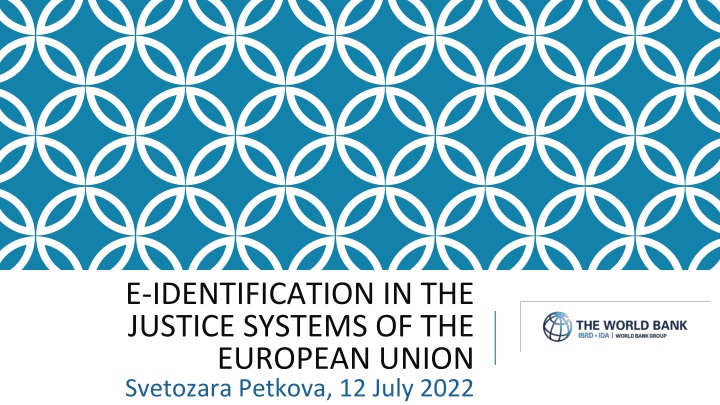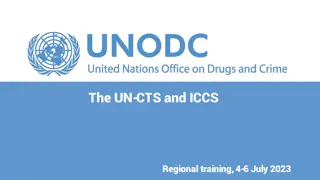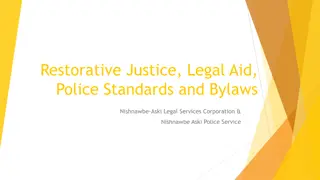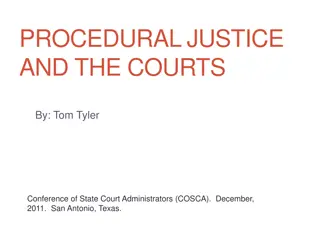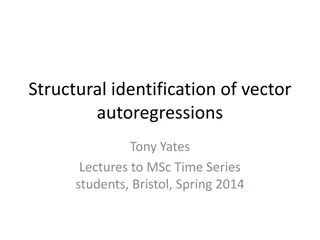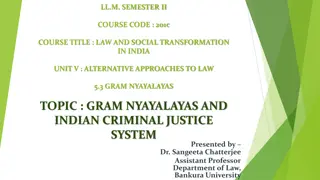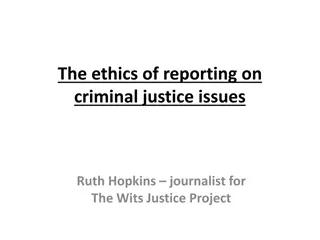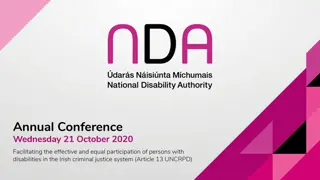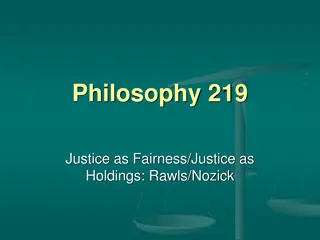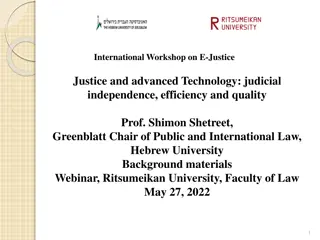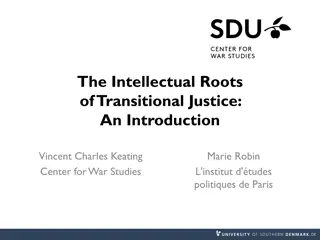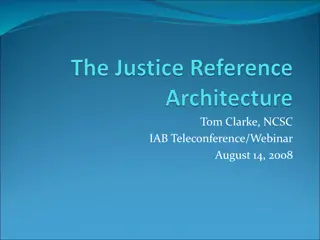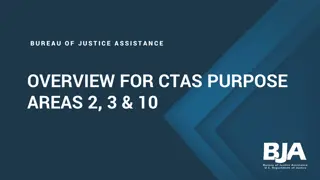E-Identification in EU Justice Systems
E-Identification plays a crucial role in the European Union justice systems, enabling secure electronic communication among enforcement agents, courts, banks, public agencies, and private parties. International frameworks like the UNCITRAL Model Law on Electronic Signatures and the UN Convention on Electronic Communications ensure the reliability and legal validity of electronic signatures. The evolution of e-signatures and e-identification in the EU, governed by regulations like eIDAS, has paved the way for different types of e-signatures and trust services.
Download Presentation

Please find below an Image/Link to download the presentation.
The content on the website is provided AS IS for your information and personal use only. It may not be sold, licensed, or shared on other websites without obtaining consent from the author.If you encounter any issues during the download, it is possible that the publisher has removed the file from their server.
You are allowed to download the files provided on this website for personal or commercial use, subject to the condition that they are used lawfully. All files are the property of their respective owners.
The content on the website is provided AS IS for your information and personal use only. It may not be sold, licensed, or shared on other websites without obtaining consent from the author.
E N D
Presentation Transcript
E-IDENTIFICATION IN THE JUSTICE SYSTEMS OF THE EUROPEAN UNION Svetozara Petkova, 12 July 2022
IMPORTANCE OF E-IDENTIFICATION FOR E-ENFORCEMENT Ability of enforcement agents/bailiffs/judicial officers to communicate securely and electronically with: courts; banks; public agencies; private parties. Ability of clients (e.g., creditors) to communicate securely with enforcement agents. Ability of other participants in enforcement procedures (e.g., buyers in e- auctions) to communicate securely and electronically with the enforcement agent/ with the e-auction platform.
INTERNATIONAL / CROSS-BORDER INSTRUMENTS 2001 UNCITRAL Model Law on Electronic Signatures Electronic signature is considered reliable if the signature creation data are (a) linked to the signatory and no other person; (b) were, at the time of signing, under the control of the signatory and no other person; (c) any alteration, made after the signing, is detectable; and (d) where a purpose of the signature is to provide assurance of the integrity of information to which it relates, alterations made to that information after signing are detectable. Technological neutrality (the Model Law does not determine the technology for achieving the purposes) States can determine what signatures meet the reliability requirement. 2005 United Nations Convention on the Use of Electronic Communications in International Contracts Sets out criteria for establishing functional equivalence between electronic communications and paper documents, as well as between electronic authentication methods and handwritten signatures. Establishes the principle that communications are not to be denied legal validity solely on the grounds that they were made in electronic form. So far only 15 parties to the convention.
EVOLUTION OF E-SIGNATURE AND E-IDENTIFICATION IN THE EUROPEAN UNION EU Regulation (EU) No. 910/2014 on Electronic Identification and Trust Services for Electronic Transactions in the European Internal Market (eIDAS) Directive 1999/93/EC on a Community Framework for Electronic Signatures The Directive is an act that sets a goal, which member states should achieve; to implement the directive, each member state shall enact its own national laws. The Directive regulates two types of e- signatures: simple and advanced ones The Regulation is a legislative act that is directly applicable in all member states. The Regulation provides for three types of e-signatures: simple, advanced and qualified ones. In addition to electronic signatures, the Regulation covers electronic seals, electronic time stamps, electronic registered delivery services
TYPES OF E-SIGNATURES UNDER EIDAS Electronic signature means data in electronic form which is attached to or logically associated with other data in electronic form and which is used by the signatory to sign (i.e., lowest security level) Advanced electronic signature has higher security by using certificates, cryptographic keys and similar forms of secure login. This e-signature is: Qualified electronic signature means an advanced electronic signature that is created by a qualified electronic signature creation device, and which is based on a qualified certificate for electronic signatures. uniquely linked to the signatory; capable of identifying the signatory; created using electronic signature creation data that the signatory can use under his sole control, with a high level of confidence, and linked to the data signed therewith in such a way that any subsequent change in the data is detectable.
LEGAL EFFECTS OF E-SIGNATURES Qualified electronic signature has legal effect equivalent to that of a handwritten signature in all member states. Electronic signature and advanced electronic signature cannot be denied legal effect and admissibility as evidence in legal proceedings solely on the grounds of them being in electronic form or not meeting the requirements for a qualified e-signature. Public and private entities in member states are free to determine the legal effects of the simple and the advanced e-signature in their relationships and governments are free to recognize electronic identification means with lower identity assurance levels than that of a qualified e-signature. Additionally, eIDAS allows public sector bodies in member states to provide e- services based both on qualified e-signatures and on advanced ones.
WHO ISSUES E-SIGNATURES: TRUST SERVICE PROVIDERS Qualified trust service providers Entities issuing qualified certificates for electronic signatures. They should be certified by a designated supervisory body in the respective Member State. They are subject to both (1) ex-ante supervision, i.e., supervision before they are granted qualified status to ensure that all the prerequisites for the provision of services are in place, and (ii) ex-post supervision, i.e., various kinds of assessments and inspections to ensure that they act in conformity with the law. Non-qualified trust service providers Provide services such as issuance of advanced e-signatures. They are subject to a light touch supervision. and ex-post
Supervisory body Carries out: (i) ex-ante supervision, i.e. granting of qualified status to trust service providers and ensuring that all the prerequisites for the provision of services are in place, and (ii) ex-post supervision of both qualified and non-qualified trust service providers, i.e. various kinds of assessments and inspections to ensure that trust service providers act in conformity with the law. SUPERVISO RY FRAMEWOR K Conformity assessment body Carries out conformity assessment of qualified trust service providers against pre-defined technical, functional, and organizational standards. The resulting conformity assessment reports are submitted to the supervisory body. National accreditation body Accredits conformity assessment bodies.
electronic seal means data in electronic form, which is attached to or logically associated with other data in electronic form to ensure the latter s origin and integrity (simple, advanced, qualified): Unlike an electronic signature, which can be associated both with natural and legal persons, an electronic seal is associated only with legal person. It can be generated automatically. OTHER ELEMENTS OF EIDAS electronic time stamp means data in electronic form which binds other data in electronic form to a particular time establishing evidence that the latter data existed at that time (simple, qualified) electronic registered delivery service means a service that makes it possible to transmit data between third parties by electronic means and provides evidence relating to the handling of the transmitted data, including proof of sending and receiving the data, and that protects transmitted data against the risk of loss, theft, damage or any unauthorised alterations (simple, qualified)
TOPICS FOR DISCUSSION How to enhance use of e-identification by professional users? How to enhance use of e-identification by citizens? How to enhance cross-border use of e-identification? What role do regional alliances have to play? ?
